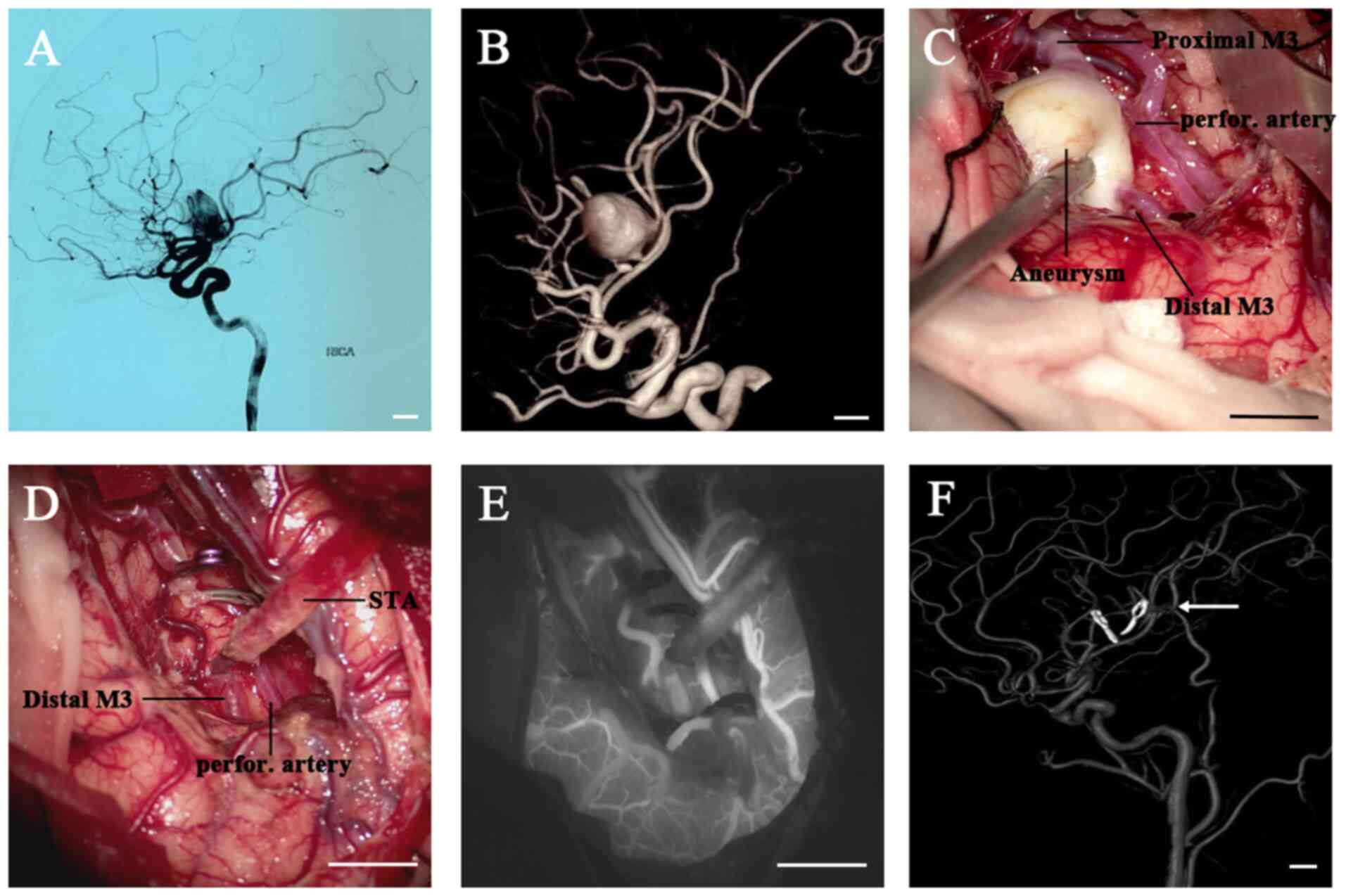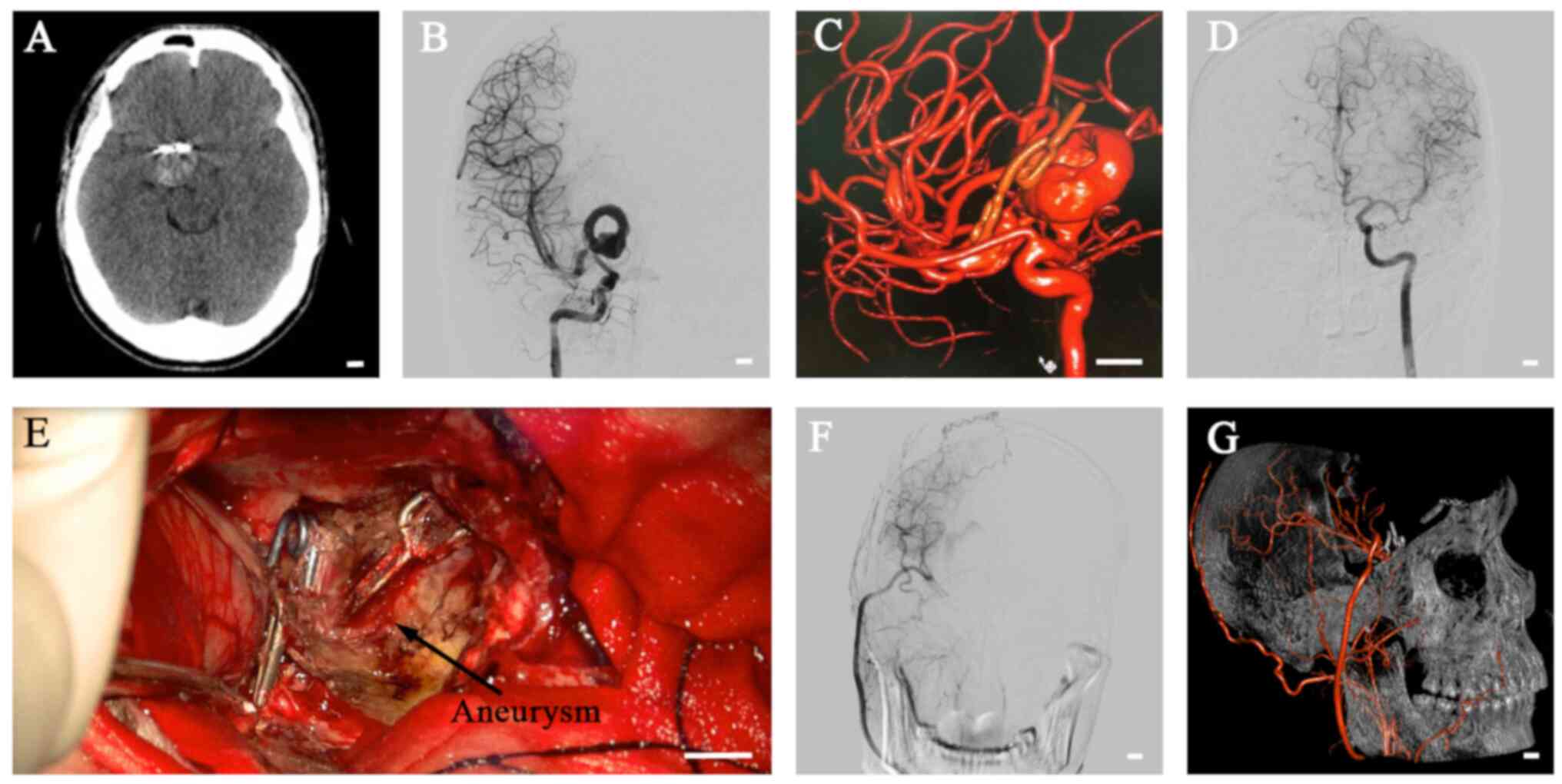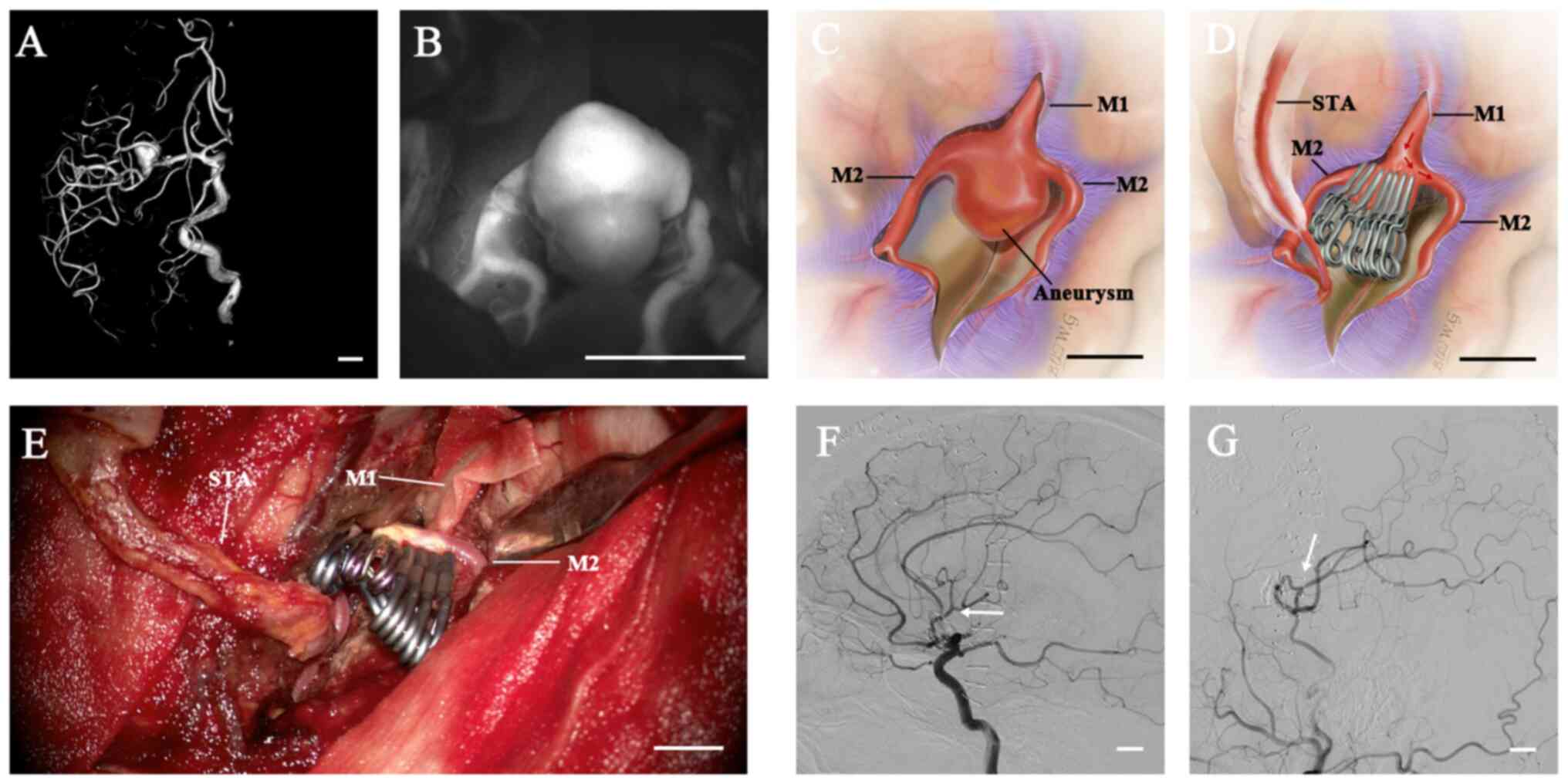|
1
|
Smith TR, Cote DJ, Dasenbrock HH, Hamade
YJ, Zammar SG, El Tecle NE, Batjer HH and Bendok BR: Comparison of
the efficacy and safety of endovascular coiling versus
microsurgical clipping for unruptured middle cerebral artery
aneurysms: a systematic review and meta-analysis. World Neurosurg.
84:942–953. 2015.PubMed/NCBI View Article : Google Scholar
|
|
2
|
Diaz OM, Rangel-Castilla L, Barber S, Mayo
RC, Klucznik R and Zhang YJ: Middle cerebral artery aneurysms: A
single-center series comparing endovascular and surgical treatment.
World Neurosurg. 81:322–329. 2014.PubMed/NCBI View Article : Google Scholar
|
|
3
|
Steklacova A, Bradac O, Charvat F, De Lacy
P and Benes V: ‘Clip first’ policy in management of intracranial
MCA aneurysms: Single-centre experience with a systematic review of
literature. Acta Neurochir (Wien). 158:533–546; discussion 546.
2016.PubMed/NCBI View Article : Google Scholar
|
|
4
|
Lu P, Zhang Y, Niu H and Wang Y:
Comparison of endovascular treatment for middle cerebral artery
aneurysm with a low-profile visualized intraluminal support stent
or pipeline embolization device. Exp Ther Med. 18:2072–2078.
2019.PubMed/NCBI View Article : Google Scholar
|
|
5
|
Jeong SM, Kang SH, Lee NJ and Lim DJ:
Stent-assisted coil embolization for the proximal middle cerebral
artery fusiform aneurysm. J Korean Neurosurg Soc. 47:406–408.
2010.PubMed/NCBI View Article : Google Scholar
|
|
6
|
Nussbaum ES, Kallmes KM, Lassig JP,
Goddard JK, Madison MT and Nussbaum LA: Cerebral revascularization
for the management of complex intracranial aneurysms: A
single-center experience. J Neurosurg: Oct 1, 2018 (Epub ahead of
print).
|
|
7
|
Choi IS and David C: Giant intracranial
aneurysms: Development, clinical presentation and treatment. Eur J
Radiol. 46:178–194. 2003.PubMed/NCBI View Article : Google Scholar
|
|
8
|
Drake CG and Peerless SJ: Giant fusiform
intracranial aneurysms: Review of 120 patients treated surgically
from 1965 to 1992. J Neurosurg. 87:141–162. 1997.PubMed/NCBI View Article : Google Scholar
|
|
9
|
Fulkerson DH, Voorhies JM, Payner TD,
Leipzig TJ, Horner TG, Redelman K and Cohen-Gadol AA: Middle
cerebral artery aneurysms in children: Case series and review. J
Neurosurg Pediatr. 8:79–89. 2011.PubMed/NCBI View Article : Google Scholar
|
|
10
|
Quiñones-Hinojosa A and Lawton MT: In situ
bypass in the management of complex intracranial aneurysms:
Technique application in 13 patients. Neurosurgery. 57 (Suppl
1):140–145; discussion 140-145. 2005.PubMed/NCBI View Article : Google Scholar
|
|
11
|
Sekhar LN, Stimac D, Bakir A and Rak R:
Reconstruction options for complex middle cerebral artery
aneurysms. Neurosurgery. 56 (Suppl 1):66–74; discussion 66-74.
2005.PubMed/NCBI View Article : Google Scholar
|
|
12
|
van Doormaal TP, van der Zwan A, Verweij
BH, Han KS, Langer DJ and Tulleken CA: Treatment of giant middle
cerebral artery aneurysms with a flow replacement bypass using the
excimer laser-assisted nonocclusive anastomosis technique.
Neurosurgery. 63:12–20; discussion 20-22. 2008.PubMed/NCBI View Article : Google Scholar
|
|
13
|
Aboukais R, Verbraeken B, Leclerc X,
Gautier C, Vermandel M, Bricout N, Lejeune JP and Menovsky T:
Protective STA-MCA bypass to prevent brain ischemia during
high-flow bypass surgery: Case series of 10 patients. Acta
Neurochir (Wien). 161:1207–1214. 2019.PubMed/NCBI View Article : Google Scholar
|
|
14
|
Tayebi Meybodi A, Huang W, Benet A, Kola O
and Lawton MT: Bypass surgery for complex middle cerebral artery
aneurysms: An algorithmic approach to revascularization. J
Neurosurg. 127:463–479. 2017.PubMed/NCBI View Article : Google Scholar
|
|
15
|
Lan J, Fu ZY, Zhang JJ, Ma C, Cao CJ, Zhao
WY, Jiang PC and Chen JC: Giant serpentine aneurysm of the middle
cerebral artery. World Neurosurg. 117:109–114. 2018.PubMed/NCBI View Article : Google Scholar
|
|
16
|
Kivipelto L, Niemelä M, Meling T, Lehecka
M, Lehto H and Hernesniemi J: Bypass surgery for complex middle
cerebral artery aneurysms: Impact of the exact location in the MCA
tree. J Neurosurg. 120:398–408. 2014.PubMed/NCBI View Article : Google Scholar
|
|
17
|
Wang L, Lu S, Cai L, Qian H, Tanikawa R
and Shi X: Internal maxillary artery bypass for the treatment of
complex middle cerebral artery aneurysms. Neurosurg Focus.
46(E10)2019.PubMed/NCBI View Article : Google Scholar
|
|
18
|
Xu F, Xu B, Huang L, Xiong J, Gu Y and
Lawton MT: Surgical Treatment of Large or Giant Fusiform Middle
Cerebral Artery Aneurysms: A Case Series. World Neurosurg.
115:e252–e262. 2018.PubMed/NCBI View Article : Google Scholar
|
|
19
|
Banks JL and Marotta CA: Outcomes validity
and reliability of the modified Rankin scale: implications for
stroke clinical trials: a literature review and synthesis. Stroke.
38:1091–1096. 2007.PubMed/NCBI View Article : Google Scholar
|
|
20
|
Konczalla J, Seifert V, Beck J, Güresir E,
Vatter H, Raabe A and Marquardt G: Outcome after Hunt and Hess
Grade V subarachnoid hemorrhage: A comparison of pre-coiling era
(1980-1995) versus post-ISAT era (2005-2014). J Neurosurg.
128:100–110. 2018.PubMed/NCBI View Article : Google Scholar
|
|
21
|
al-Yamany M and Ross IB: Giant fusiform
aneurysm of the middle cerebral artery: Successful Hunterian
ligation without distal bypass. Br J Neurosurg. 12:572–575.
1998.PubMed/NCBI View Article : Google Scholar
|
|
22
|
Rodríguez-Hernández A, Sughrue ME, Akhavan
S, Habdank-Kolaczkowski J and Lawton MT: Current management of
middle cerebral artery aneurysms: Surgical results with a ‘clip
first’ policy. Neurosurgery. 72:415–427. 2013.PubMed/NCBI View Article : Google Scholar
|
|
23
|
Heros RC and Fritsch MJ: Surgical
management of middle cerebral artery aneurysms. Neurosurgery.
48:780–785; discussion 785-786. 2001.PubMed/NCBI View Article : Google Scholar
|
|
24
|
Kim LJ, Klopfenstein JD and Spetzler RF:
Clip reconstruction and sling wrapping of a fusiform aneurysm:
Technical note. Neurosurgery. 61 (Suppl 3):79–80; discussion 80.
2007.PubMed/NCBI View Article : Google Scholar
|
|
25
|
Yang I and Lawton MT: Clipping of complex
aneurysms with fenestration tubes: Application and assessment of
three types of clip techniques. Neurosurgery. 62 (Suppl
2):ONS371–ONS378; discussion 378-379. 2008.PubMed/NCBI View Article : Google Scholar
|
|
26
|
Sanai N, Zador Z and Lawton MT: Bypass
surgery for complex brain aneurysms: An assessment of
intracranial-intracranial bypass. Neurosurgery. 65:670–683;
discussion 683. 2009.PubMed/NCBI View Article : Google Scholar
|
|
27
|
Zhu W, Liu P, Tian Y, Gu Y, Xu B, Chen L,
Zhou L and Mao Y: Complex middle cerebral artery aneurysms: A new
classification based on the angioarchitecture and surgical
strategies. Acta Neurochir (Wien). 155:1481–1491. 2013.PubMed/NCBI View Article : Google Scholar
|
|
28
|
Cimflova P, Özlük E, Korkmazer B, Ahmadov
R, Akpek E, Kizilkilic O, Islak C and Kocer N: Long-term safety and
efficacy of distal aneurysm treatment with flow diversion in the M2
segment of the middle cerebral artery and beyond. J Neurointerv
Surg: Oct 20, 2020 (Epub ahead of print).
|
|
29
|
Topcuoglu OM, Akgul E, Daglioglu E,
Topcuoglu ED, Peker A, Akmangit I, Belen D and Arat A: Flow
diversion in middle cerebral artery aneurysms: is it really an
all-purpose treatment? World Neurosurg. 87:317–327. 2016.PubMed/NCBI View Article : Google Scholar
|
|
30
|
Zanaty M, Chalouhi N, Tjoumakaris SI,
Gonzalez LF, Rosenwasser R and Jabbour P: Flow diversion for
complex middle cerebral artery aneurysms. Neuroradiology.
56:381–387. 2014.PubMed/NCBI View Article : Google Scholar
|
|
31
|
Shi ZS, Ziegler J, Duckwiler GR, Jahan R,
Frazee J, Ausman JI, Martin NA and Viñuela F: Management of giant
middle cerebral artery aneurysms with incorporated branches:
Partial endovascular coiling or combined extracranial-intracranial
bypass - a team approach. Neurosurgery. 65 (Suppl 6):121–129;
discussion 129-131. 2009.PubMed/NCBI View Article : Google Scholar
|

















